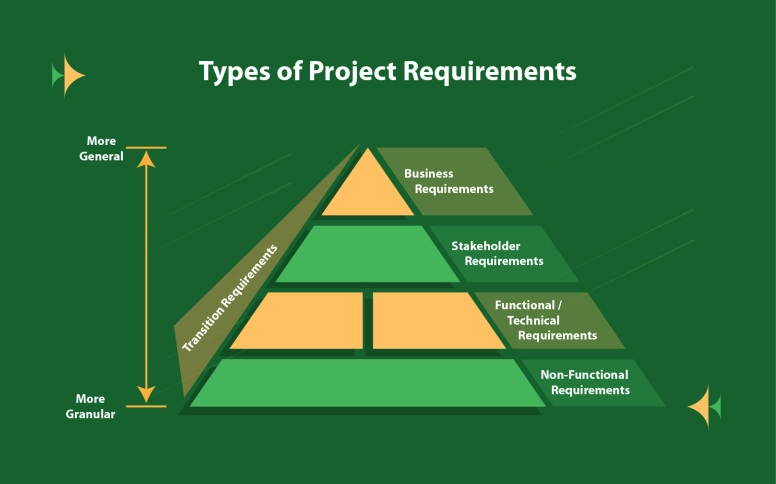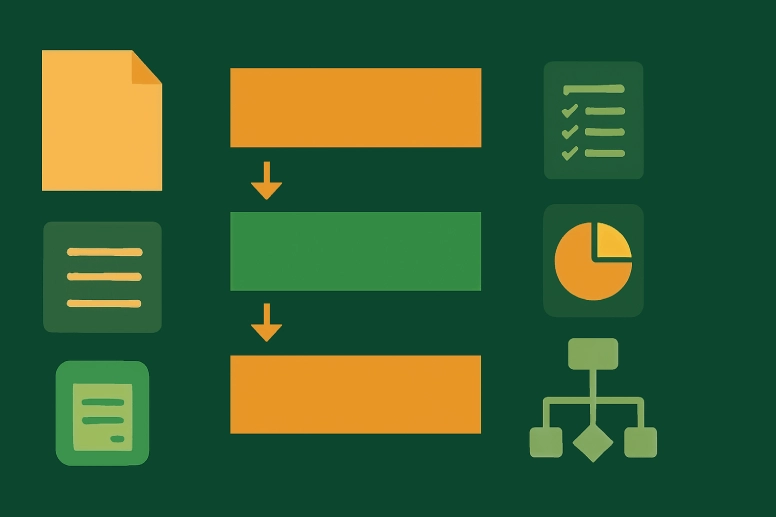How to Write and Document Project Requirements
- Understanding Project Requirements
- Types of Project Requirements
- How to Write Effective Project Requirements in Six Steps
- How to Document Project Requirements: 3 Tips to Follow
- Common Challenges and How to Overcome Them
- How to Write and Document Project Requirements: Best Practices
- From Chaos to Clarity: Mastering Project Requirements
This blog post explains how to write and document project requirements. It'll equip you with the tools and best practices to navigate this vital part of project management – no matter your experience level.
Understanding Project Requirements
Project requirements include the specific needs, expectations, and constraints a project must meet to be successful. They describe what the project should deliver, how these deliverables should work, and any applicable limitations or conditions.
Think of project requirements as the building blocks of your project plan. They provide a clear framework for:
- Planning
- Execution
- Evaluation
- Control
Telling Project Requirements Apart from Objectives
The terms "project requirements" and "project objectives" are related. However, they are not the same, so it is important to understand their differences for effective project planning and execution.
Let’s look at some of their features in the table below:
| Feature | Project Objectives | Project Requirements |
|
Definition |
The project’s overarching goals and desired outcomes. |
Specific needs, expectations, and constraints that the team should meet. |
|
Focus |
What the project aims to achieve. |
How the project will be achieved. |
|
Measurability |
They may be less specific and more aspirational. |
Often measurable and testable. |
|
Example |
Increase user engagement by 20% in the following year. |
The website should enable users to make online payments. |
These examples show project requirements are more specific and focus on details. Objectives provide a broader vision of the desired outcomes.
Types of Project Requirements
To effectively manage project requirements, it's crucial to recognize their diverse nature.
We can categorize project requirements into various types with varying levels of specificity or granularity.
Each type of requirement has a specific purpose within the project. We explain further below.
Business Requirements
Business requirements describe the project’s high-level objectives and goals from a business perspective. They answer the question, "Why are we undertaking this project?"
They help the team members align the project with the overall business strategy.
Examples of business requirements include:
- Increasing efficiency in a particular process.
- Expanding market share in a new region.
- Offering new features to improve customer satisfaction.
Stakeholder Requirements
Project stakeholder requirements refer to the specific needs and expectations of anyone interested in or affected by the project outcomes. They are about ensuring the project meets everyone's needs. User requirements are part of the stakeholder requirements, but there are more.
These could be the stakeholders involved:
- Project sponsor or product owner – The individual or group funding and directing the project.
- Project team members – The individuals taking part in the project, such as the product development team and product managers.
- End users – These are team members who work on the project's deliverables.
- Customers – The end-users or beneficiaries of the project's outcome.
Functional Requirements
Functional requirements translate stakeholder requirements into the functionalities and features the project must deliver. They describe what the system or product should do and how it should behave.
According to the Project Management Institute, functional requirements are best captured when using the "User Story" and "Case Study" formats. These formats provide a clear understanding of how users will interact with the system.
Some examples of functional requirements include:
- "The hotel should provide guests a live-like-a-local experience."
- "The application must provide a search function to find other users based on their name or email."
- "The website should let users make online payments."
Technical Requirements
Technical requirements describe the technical constraints and specifications a project must meet. For instance, in software development, these address different aspects, such as hardware, software, and infrastructure. They also include programming languages that development teams must use.
Technical requirements are detailed descriptions of all technical terms. These ensure that the project meets performance requirements as well as security and compatibility standards.
A few examples of technical requirements include:
- "The database should be able to handle a minimum of 10,000 concurrent users."
- "The application should be developed using Java programming language."
- "The system must be compatible with iOS and Android devices."
Non-Functional Requirements
Non-functional requirements are qualities and characteristics of a project's deliverables rather than specific functionalities. They address performance, security, usability, reliability, and maintainability.
With these requirements, the project can focus on meeting user expectations (what the user expects) and delivering a positive experience.
Examples include:
- "The system should load pages within 3 seconds."
- "The website should be accessible to users with different disabilities."
- "The application must comply with industry security standards."
Transition Requirements
Transition requirements define the temporary activities that help transition from the current state to the desired future state after completing a project. These may include one-time processes like data migration, training, and organizational changes.
Technical requirements might include:
- "Migrate existing data to the new cloud storage system within the next month."
- "Train employees on using the new software."
- "Update organizational processes to align with the new system."
How to Write Effective Project Requirements in Six Steps
Writing effective project requirements involves translating high-level objectives and stakeholder needs into clear, concise, actionable statements.
Here are six steps to master this essential process.
Step 1. Craft a Project Requirements Management Plan
The first step is creating a plan to help you manage requirements throughout the project lifecycle more effectively. This includes a specified, fleshed-out version of the steps you'll find below. It covers the following key elements:
- Requirements gathering process – This section defines how you'll collect requirements from stakeholders.
- Documentation standards – Here, you'll establish project document templates and guidelines for documenting requirements.
- Prioritization process – This section describes how you'll prioritize conflicting or competing requirements.
- Change management process – Finally, the plan should outline how you'll handle changes to requirements during the project.
Step 2. Develop or Choose a Standard Template
Requirements are organized and presented in a Project Requirements Document (PRD) or Business Requirements Document (BRD). This is where templates can be helpful.
Standardized project requirements templates ensure that requirements are not only consistent but clear and complete. A template for a PRD or BRD typically includes sections for:
- Introduction and project overview – This provides context and background information.
- Goals and objectives – This section defines the overall goals and measurable objectives.
- Scope and deliverables – This part outlines what the project includes and excludes.
- Specific requirements – This part describes the functional, technical, and non-functional requirements.
- Assumptions and constraints – Here, you can identify any assumptions made and limitations faced.
Step 3. Document Project Requirements from All Stakeholders
You should actively involve all key stakeholders in the requirements-gathering process.
Various techniques can help you collect their input. These include:
- Interviews
- Workshops
- Surveys, and others.
Document everything meticulously, ensuring you capture all requirements accurately and comprehensively.
Step 4. Write SMART Requirements
After documenting all the requirements based on stakeholder inputs, it is time for the project manager to interpret them and write them out properly. Just like business objectives, project requirements should be SMART:
- Specific – Clearly define what the project requires.
- Measurable – The project manager has to Include criteria for evaluating success.
- Achievable – This means including requirements that are realistic and attainable.
- Relevant – Align with project goals and business objectives.
- Time-bound – Include deadlines or timeframes for completion.
Due to their actionable and time-sensitive nature, you must define project requirements even more diligently than objectives.
Step 5. Prioritize Requirements
Different project stakeholders will have different expectations. This can sometimes lead to conflicting requirements. Consequently, you'll have to prioritize some requirements over others.
You can rank requirements to determine which are essential and which are optional. Prioritization frameworks like the MoSCoW method (Must have, Should have, Could have, Won't have) can also help with this.
The idea is to ensure the project team knows which of two conflicting requirements to choose and focus on delivering the most critical functionalities first.
Step 6. Generate Visuals
Some people struggle with text. However, visuals, like diagrams, flowcharts, and mockups, make understanding project requirements easier.
Use visuals to present requirements and provide an intuitive view of the desired outcomes. This will facilitate collaboration and reduce the risk of misinterpretations.
How to Document Project Requirements: 3 Tips to Follow
You must document your project requirements before writing them out. Here are three tips for doing this better.
Tip #1. Choose the Right Tools
You have to have the right tools for the job, as these can significantly impact efficiency and collaboration.
For example, sharing PRDs in PDF format is sometimes better than sharing editable documents. Using a tool like a free PDF editor lets you update requirements, add comments, and share finalized documents in a format that won't get accidentally altered.
On the other hand, dedicated project documentation software offers several advantages.
Flowlu, for instance, provides a centralized platform for managing all project-related information, including requirements and tasks. This tool streamlines documentation and enhances team collaboration.
Tip #2. Maintain Version History
Requirements evolve as projects do. To prevent confusion and ensure everyone is working with the latest information, you'll want to track changes and maintain a clear version history.
Project management software often includes version control tools and features to help you manage revisions, track approvals, and revert to previous versions if necessary.
Tip #3. Ensure Approvals
Preventing scope creep and ensuring everyone understands the project's direction goes through a properly documented approval process. This process should include a clear review and sign-off procedure involving all key stakeholders.
Clearly approved project requirements are the foundation of successful project execution. Yet even well-structured requirements can suffer from ambiguity, inconsistencies, or grammatical errors.
These errors can lead to misunderstandings and misinterpretations among stakeholders.
A grammar checker tool helps ensure clarity by catching typos and improving sentence structure. It reinforces consistency in terminology, enhances readability, and minimizes the risk of misinterpretation, leading to a more streamlined approval process.
Common Challenges and How to Overcome Them
Challenges can arise when writing and documenting project requirements even with the best planning and processes. Recognizing and proactively addressing these potential pitfalls is crucial for keeping your project on track.
Scope Creep
According to Martina Huemann and Rodney Turner, authors of The Handbook of Project Management, scope creep is the uncontrolled change in project scope beyond the original plan. It is a common challenge that can derail projects, and it is the project manager's job to keep it in check.
You can prevent scope creep by:
- Establishing a clear and comprehensive project scope.
- Implementing robust change management processes.
- Fostering open communication and collaboration among stakeholders.
- Reviewing and updating requirements regularly to reflect any changes.
Unclear Requirements
As mentioned above, ambiguous or incomplete requirements can lead to misinterpretations, rework, and delays.
To ensure clarity, you should:
- Write requirements in active voice – for example, instead of writing “programming language X should be used”, write “software developers should use programming language 1”.
- Use precise language and avoid jargon.
- Break down requirements into smaller, more manageable units when possible.
- Use visuals to illustrate complex concepts.
- Validate requirements with stakeholders to confirm understanding.
Lack of Stakeholder Involvement
Insufficient stakeholder engagement can result in missed requirements, misaligned expectations, and project failure. To foster stakeholder involvement:
- Identify all key stakeholders early on.
- Establish clear communication channels.
- Regularly engage stakeholders through meetings, workshops, and feedback sessions.
- Ensure stakeholders understand the importance of their input.
- Acknowledge and address stakeholder concerns promptly.
How to Write and Document Project Requirements: Best Practices
Writing and documenting project requirements is as much science as it is art. It is an ongoing process that requires continuously refining your approach and adopting best practices.
Regularly Review and Update Requirements
Project requirements are not static. They evolve as the project progresses and business needs change. Review and update your requirements document regularly to ensure it is always relevant and accurately reflects the current project scope.
Use a Collaborative Approach
Collaboration is key to successful project requirements management. Foster a collaborative environment where project team members, stakeholders, and subject matter experts can contribute their knowledge and insights. Utilize tools and platforms that facilitate communication and knowledge sharing, such as Flowlu's collaborative workspace.
Focus on the "Why"
Understanding the underlying reasons behind each requirement can lead to better solutions and prevent unnecessary features. When writing requirements, constantly ask yourself "why" this requirement is necessary and how it contributes to the project's goals.
This fosters a deeper understanding of the project's purpose and helps prioritize the most valuable requirements.
From Chaos to Clarity: Mastering Project Requirements
Knowing how to write and document project requirements ensures that everything is under control. Follow the steps, tips, and best practices we have outlined in this article, so that every team member knows what their responsibilities are.
Doing so can avoid frustration, as the workflow is smoother leading to a successful project.
Ready to level up your project requirements management? Explore Flowlu's comprehensive suite of project management tools to help you streamline workflows and enhance collaboration.
Project objectives define what the project aims to achieve—like increasing customer retention or expanding into a new market. Project requirements, on the other hand, define how you’ll get there. They include the specific features, functions, constraints, and technical details that guide the work. Think of objectives as the destination and requirements as the GPS directions to get there.
Use the SMART framework—make each requirement Specific, Measurable, Achievable, Relevant, and Time-bound. Write in active voice, avoid vague or technical jargon (unless it’s necessary), and break complex ideas into smaller parts. Adding visuals like flowcharts or mockups can also make your requirements easier to understand.
Start with a solid requirements management plan, involve stakeholders early, and get written approvals. Also, have a clear change management process in place. If someone suggests a change mid-project, assess its impact before saying yes. Updating documentation and communicating changes quickly helps everyone stay aligned and prevents confusion later.

















